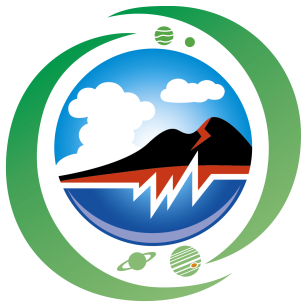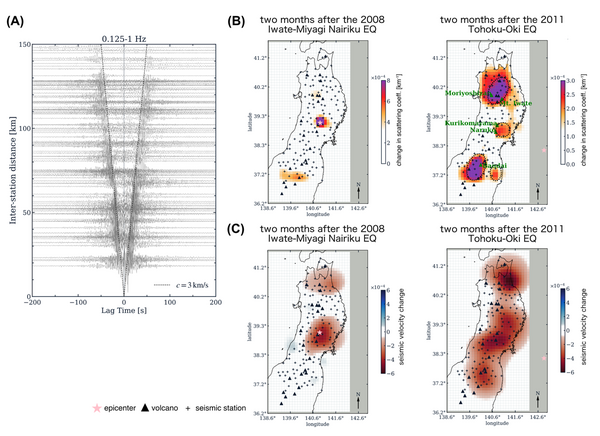Topics 2024.07.02
Subsurface structural changes associated with large earthquakes probed by seismic ambient noise
Figure 1. (A) Seismic ambient noise cross-correlation functions, ordered by distance between two seismic stations. (B) Spatial distribution of seismic scattering coefficient changes in the subsurface before and after the two earthquakes. The largest changes occur in the purple region. (C) Spatial distribution of seismic velocity changes in the subsurface before and after the two earthquakes. Red regions indicate areas where seismic velocities decreased.
Even in the absence of earthquakes, seismic stations worldwide record weak permanent vibrations, which are known as 'seismic ambient noise'. Traditionally, seismic ambient noise has been regarded as 'noise' that interferes with conventional seismic observations. However, a method has been developed to extract seismic waves propagating between two stations by calculating the cross-correlation function (CCF) of their seismic ambient noise records. This technique is now widely utilized globally.
Figure 1A displays the waveforms of CCFs calculated from seismic ambient noise records at seismic stations in the Tohoku region, arranged in order of inter-station distance. The horizontal axis represents lag time, with positive lag times corresponding to seismic waveforms propagating from one station to another, and negative lag times indicating propagation in the opposite direction. Notably, seismic waves propagating between station pairs can be extracted even for distances exceeding 100 km. When seismic ambient noise CCFs can be calculated daily, effectively providing daily data equivalent to earthquakes occurring at the same location. Consequently, by analyzing changes in the travel-time of CCFs and alterations in waveform shapes, we can continuously monitor changes in the subsurface structure.
Hirose and Wang et al. (2023) investigated changes in the subsurface structure of the Tohoku region by estimating spatio-temporal changes in two parameters: seismic scattering coefficient and seismic velocity, before and after the 2008 Iwate-Miyagi Nairiku earthquake (M 6.9) and the 2011 Tohoku-Oki earthquake (M 9.0). The seismic scattering coefficient is an indicator of the strength of subsurface heterogeneity, and changes in this coefficient are known to alter observed seismic waveforms. Seismic velocity changes can be estimated from seismic wave travel-time changes, with previous studies reporting decreases in seismic wave velocity associated with large earthquakes. Hirose and Wang et al. (2023) examined changes in the waveform and travel-time of CCFs for each station pair before and after the earthquakes. Based on a theoretical model, Hirose and Wang et al. (2023) then estimated the locations and magnitudes of both seismic scattering coefficient changes and seismic velocity changes that could explain the observed waveform and travel-time variations.
Figure 1B illustrates the spatial distribution of changes in seismic scattering coefficients immediately following each earthquake. For the 2008 Iwate-Miyagi Nairiku earthquake, significant changes were observed around the epicenter of the main shock (indicated by a pink star), likely capturing subsurface structural changes due to strong ground motion. In contrast, for the 2011 Tohoku-Oki earthquake, significant changes occurred around inland volcanoes (areas enclosed by dotted lines in Figure 1B), rather than along the Pacific coast of Tohoku where strong ground motions were observed. Previous studies have reported fluid migration-related earthquake swarms following the Tohoku-Oki earthquake around Mt. Bandai and Mt. Moriyoshi, suggesting that these significant changes in seismic scattering coefficients were likely caused by the migration of subsurface fluids to shallower regions.
Figure 1C depicts the spatial distribution of seismic velocity changes immediately after each earthquake. The seismic velocity decrease associated with the Iwate-Miyagi Nairiku earthquake occurred in the focal region, likely due to strong ground motions, similar to the changes in seismic scattering coefficients. However, following the Tohoku-Oki earthquake, seismic velocity decreases occurred over a wide area in the Tohoku region. Unlike the changes in seismic scattering coefficients, these velocity changes were widely distributed not only around inland volcanoes but also along the Pacific coast.
Hirose and Wang et al. (2023) pioneered the simultaneous monitoring and direct spatial comparison of both seismic scattering coefficient changes and seismic velocity changes over extensive areas associated with large earthquakes. This comprehensive approach provides a novel perspective on subsurface dynamics. By conducting detailed investigations into the underlying phenomena responsible for these observed changes, and integrating additional observational data beyond these two parameters, we aim to enhance our understanding of subsurface processes. Ultimately, this research direction holds promise for the development of improved methods to detect precursory phenomena associated with earthquakes and volcanic eruptions in the future.
Reference:Hirose, T., Wang, Q.Y., Campillo, M. & Nakahara, H., 2023. Time-lapse imaging of seismic scattering property and velocity in the northeastern Japan. Earth Planet. Sci. Lett., https://doi.org/10.1016/j.epsl.2023.118321.
(Assistant Professor, Takashi Hirose, Solid Earth Physics Laboratory)

